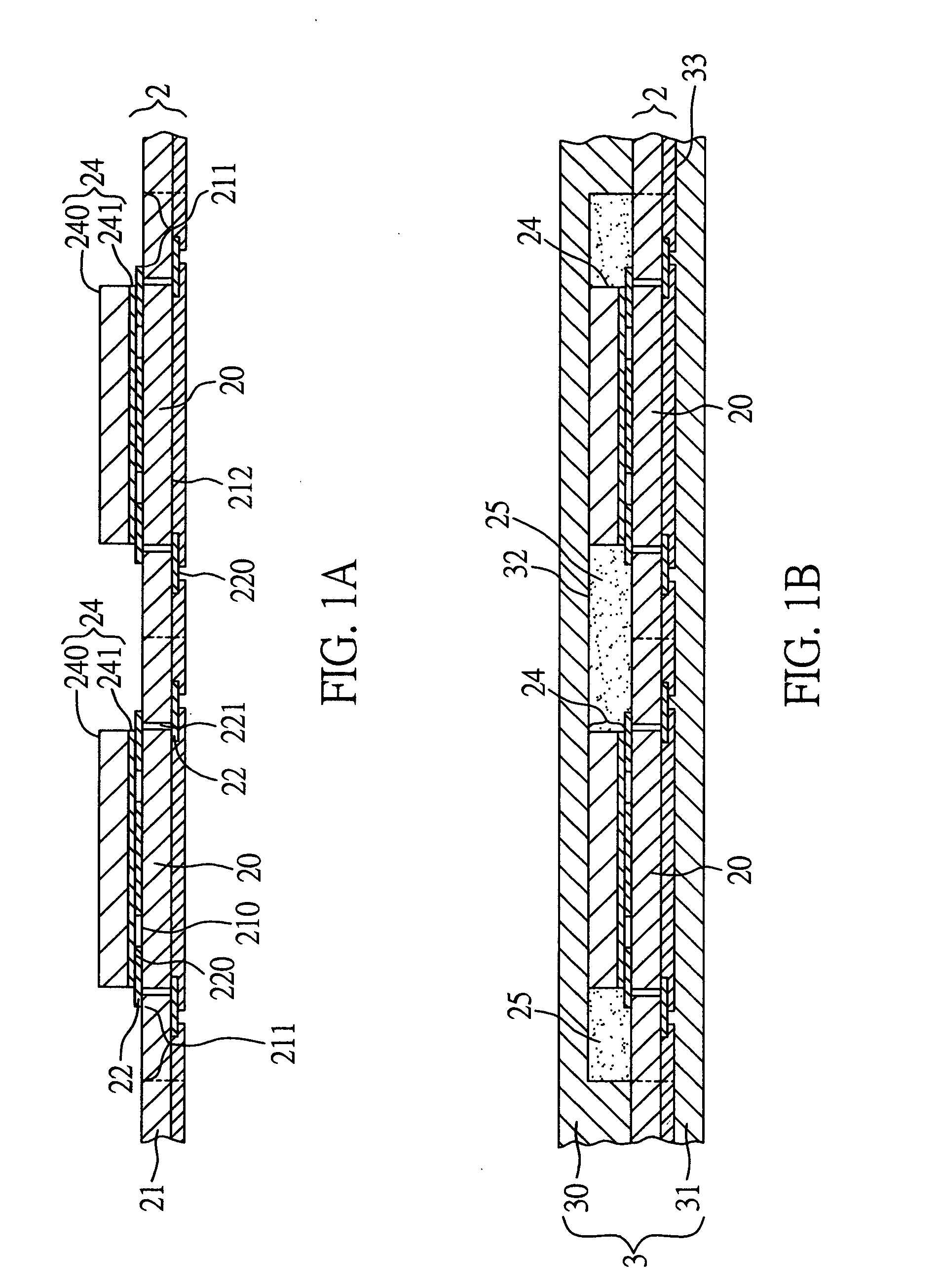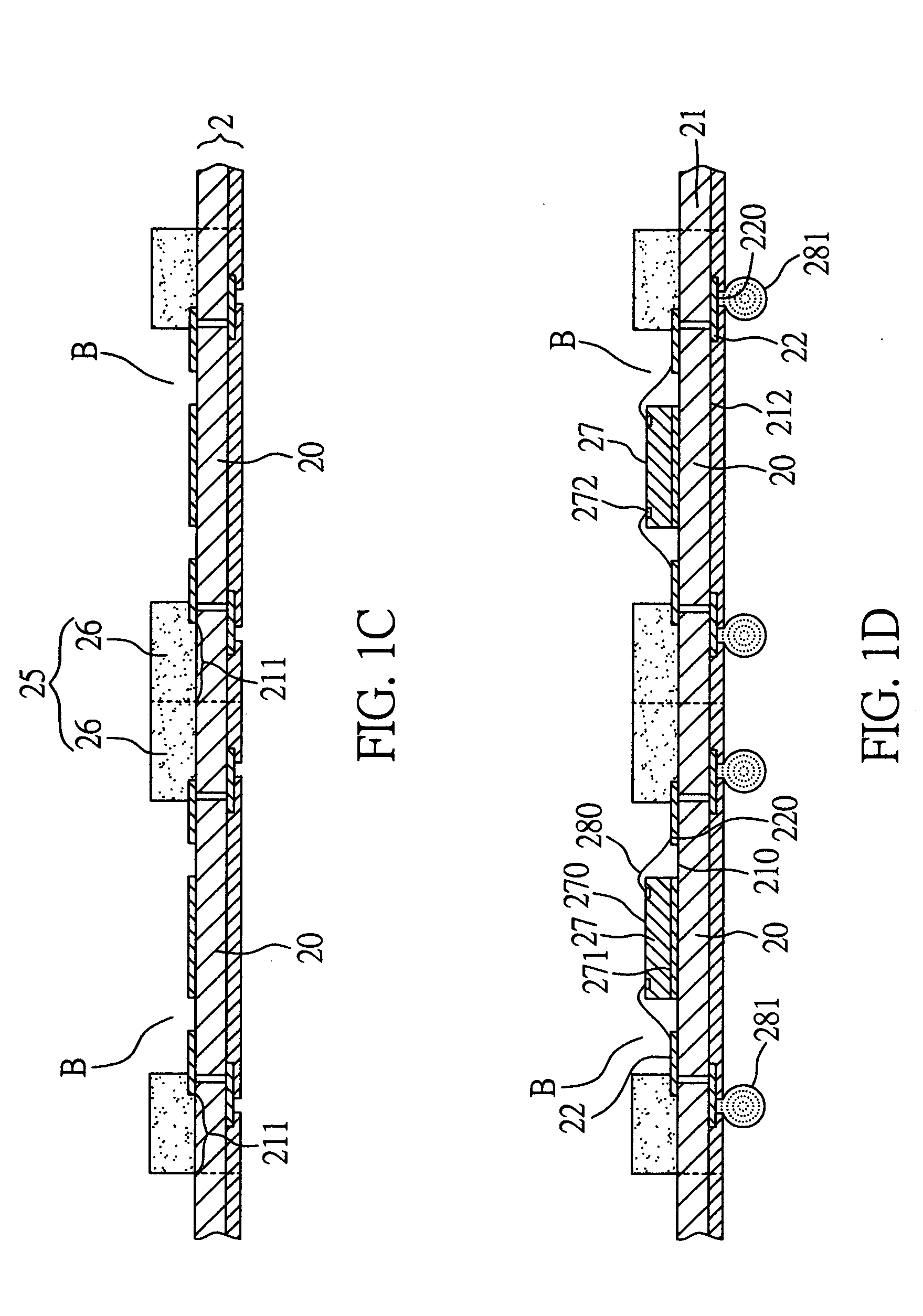Fabrication method of semiconductor package with photosensitive chip
a technology of photosensitive chips and semiconductor packages, which is applied in the direction of semiconductor devices, semiconductor/solid-state device details, electrical devices, etc., can solve the problems of damage to the reliability of the semiconductor package, the clamping force between the insert portion and the substrate is not easy to properly control, and the above semiconductor package may still suffer significant drawbacks, etc., to achieve the elimination of the damage to the substrate by the use of the insert mold, the effect of reducing the cost of manufacturing
- Summary
- Abstract
- Description
- Claims
- Application Information
AI Technical Summary
Benefits of technology
Problems solved by technology
Method used
Image
Examples
first preferred embodiment
[0022]FIGS. 1A to 1F show the procedural steps for the fabrication method according to a first preferred embodiment of the invention.
[0023] Referring to FIG. 1A, the first step is to prepare a substrate plate 2 comprising an array of substrates 20 that are integrally formed. The substrate plate 2 has a core 21 and a plurality of conductive traces 22 formed respectively on upper and lower surfaces 210, 212 of the core 21. The core 21 is primarily made of a conventional resin material such as epoxy resin, polyimide resin, BT (bismaleimide triazine) resin, FR4 resin, etc. Each of the conductive traces 22 has a terminal 220, wherein the terminals 220 on the upper surface 210 of the core 21 serve as bond fingers and the terminals 220 on the lower surface 212 of the core 21 serve as ball pads in subsequent fabrication processes. The conductive traces 22 on the upper and lower surfaces 210, 212 of the core 21 are electrically interconnected by conductive vias 221. The conductive traces 22...
second preferred embodiment
[0030]FIGS. 3A to 3E show the procedural steps for the fabrication method according to a second preferred embodiment of the invention.
[0031] Referring to FIG. 3A, the first step is to prepare a substrate plate 2′ comprising an array of integrally formed substrates 20. This substrate plate 2′ is similar in structure to the substrate plate 2 of the above first embodiment (FIG. 1A), but differs in that a solder mask layer 23 (around 25 to 50 μm thick) is applied respectively over the upper and lower surfaces 210, 212 of the core 21 and covers the conductive traces 22, and the terminals 220 of the conductive traces 22 are exposed from the solder mask layers 23. The exposed terminals 220 on the upper surface 210 of the core 21 serve as bond fingers and the exposed terminals 220 on the lower surface 212 of the core 21 serve as ball pads in subsequent fabrication processes. The solder mask layer 23 is formed an opening 230 to expose a continuous peripheral portion 211′ on the upper surfac...
third preferred embodiment
[0037]FIGS. 4A to 4E show the procedural steps for the fabrication method according to a third preferred embodiment of the invention.
[0038] The fabrication method of this third embodiment is similar to that described in the above second embodiment, with the difference in that as shown FIG. 4A, the interposer 24 is mounted on the solder mask layer 23 on the upper surface 210 of the core 21 for each of the substrates 20 of the substrate plate 2′ in a manner that, the interposer 24 covers predetermined area for chip-attachment and wire-bonding on each substrate 20, and the interposer 24 protrudes from edge of the solder mask layer 23 and extends above the peripheral portion 211′ of the corresponding substrate 20. The interposer 24 protrudes from the edge of the solder mask layer 23 by a distance of from 0.1 to 1 mm, preferably 0.5 mm. As a result, a portion A of the opening 230 on each of the substrates 20 is formed by the interposer 24, the edge of the solder mask layer 23 and the co...
PUM
 Login to View More
Login to View More Abstract
Description
Claims
Application Information
 Login to View More
Login to View More - R&D
- Intellectual Property
- Life Sciences
- Materials
- Tech Scout
- Unparalleled Data Quality
- Higher Quality Content
- 60% Fewer Hallucinations
Browse by: Latest US Patents, China's latest patents, Technical Efficacy Thesaurus, Application Domain, Technology Topic, Popular Technical Reports.
© 2025 PatSnap. All rights reserved.Legal|Privacy policy|Modern Slavery Act Transparency Statement|Sitemap|About US| Contact US: help@patsnap.com



